4. STRATIFICAZIONE HUMMOCKY E CALCARENITI NEL GIURASSICO DEL BACINO UMBRO-MARCHIGIANO
Hummocky cross-stratification (HCS) and calcarenites in the Umbria-Marche basin, Middle Toarcian.
Collaboration: J.A.Vera & J.M.Molina (Granada, Jaén, Spain)
• Monaco, P. (1992): Hummocky cross-stratified deposits and turbidites in some sequences of the Umbria-Marche area (Central Italy) during the Toarcian. Sedimentary Geology, 77: 123-142.
• MONACO, P. (1994). Hummocky cross-stratification and trace-fossils in the middle Toarcian of some sequences of Umbria-Marche Apennines. 3ème Symp.Intern. de Stratigr. du Jurassique, Poitiers, 20-29 Sept, 1991. Geobios, M.S.17: 679-688.
© and permission of all colour photographs, text and charts by P. Monaco
HCS from Jurassic of central Apennines
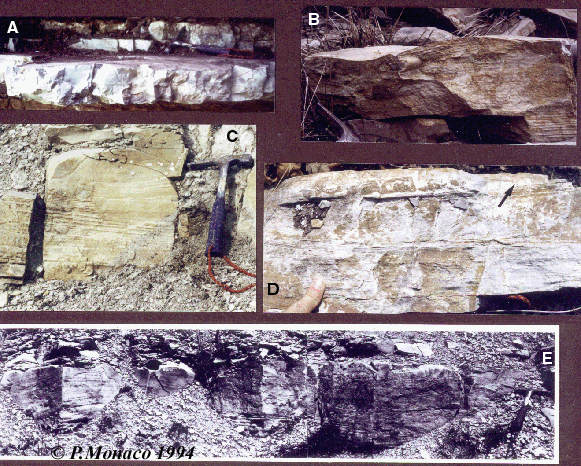
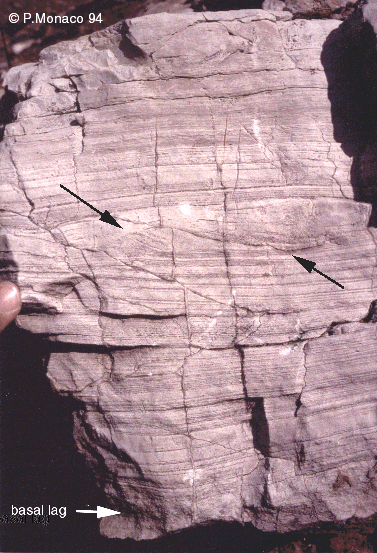
Right: planar bedded calcarenite showing HCS (wavelenghts of 80-100cm, see hammer for scale) and symmetric ripples on the top, Fiuminata area, Late Toarcian.Click to enlarge
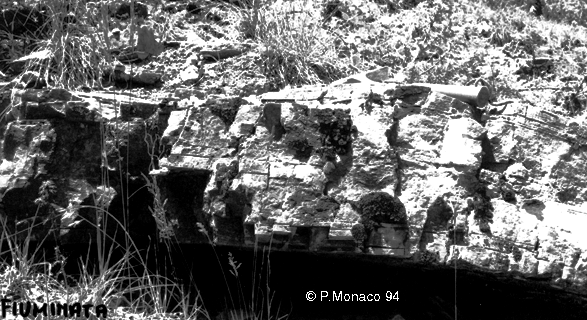
During the middle/late Lias, the Rosso Ammonitico of the Umbria-Marche Apennines received clay deposits and carbonate detritic beds. These sharp-based detrital beds, 0.5 cm to 100 cm thick, are not always induced by tectonic activity (gravity flow deposits as turbidites, slumps, breccias and pebbly mudstones, are present in the Lower Toarcian). In fact, new studies of Stratigraphy Lab of Perugia and Granada Universities seem to contrast with previous literature that refers all calcarenite beds with cross stratifications to turbidity flow deposits in a deep-water floor for tectonic pulses. In these interpretations metheorologic causes (storms) are totally rejected. The detailed sedimentological study of Rosso Ammonitico by means detailed measures of laminas and their relationships has revealed, instead, contrary to previous interpretations (Elmi, 1981), large and well preserved hummocky cross-stratified (HCS) beds. This low-angle stratification which form symmetric hummocks, 50-70cm thick, generally erosive, is well known in the literature (see the extensive bibliography in Monaco, 1992; 1994; et al. 1994). Abundant calcareous tempestites showing HCS are present in the Upper Jurassic of Spain (see Vera & Molina, 1998 with references therein). HCS beds in the middle Toarcian of Apennines, supply some proofs of vertical trends from turbidites to HCS deposits, and provide a tool to reconstruct the changes in the sea-floor depth. A result is the regressive trend of the Toarcian (see Monaco al.1994) or several shallowing-upward cycles in the Upper Jurassic of Spain, (Vera & Molina, 1998). In Italy the trace fossil behaviour is indicative for a paleoenvironmental analysis and shows variations in the oxygen content during high-energy, waning-energy and fair-weather phases of HCS events.
The HCS sequence
A complete sequence as shown in Fig.1 (upper and lower figures) consists of three divisions (see extended bibliography in Monaco 1992; 1994; et al.1994; for Spain see Molina et al.1997):
I). BIVALVE AND ECHINODERM LAG. Coarse-grained (grain-size up to 5 cm), densely packed rudstones, floatstones and/or grainstones (0.5 to 40 cm thick) constitute the lower part of a sequence (basal lag, Fig.1b). The basal contact is sharp and erosive surfaces seems to affect underlying shales. In general the lag is discontinous and massive, but direct graded bedding is present (Kreisa, 1981). The coarse fraction is composed of bivalves and/or echinoderms, micritic lithoclasts and other invertebrate remains. Crinoids ossicles locally make up to 90% of the coarse fraction (encrinites).
II). HUMMOCKY CROSS-STRATIFIED DIVISION. This division represents the middle part of a sequence (Fig.1a) and occurs generally in thick beds (up to 60 cm thick). The elliptical domes can reach 100 cm in diameter and are generally symmetrical (Fig.2), and, consequently, no consistent directional current trend can be detected. The HCS displays wavelengths mostly from 70 to 140 cm. The grain fraction consists of well sorted, fine-grained calcareous sand and silt (average grain sizes in the thin section being between 0.05 and 0.30 mm). Texturally, they are generally grainstones and matrix-poor packstones. Most grains (up to 70%) are echinoderm fragments. Micritic peloids are present (locally up to 40%), together with pebbles (up to 15%), fragments of benthic foraminifera, and/or radiolarians. Small, flat or concave, thin-shelled, disarticulated bivalves are fairly common. At least 50% of the concave valves lie with the concavity facing up.
III). CALCISILTITE-LUTITE DIVISION. This part (from 0.5 to about 20 cm thick) constitutes the upper part of the sequence (Fig. 2a). Here radiated echinid carcasses smothered by the sudden influx of mud wich blocked their vascular system have been found (Fig. 2b). The grain fraction is generally finer than I and II and consists of calcareous silt and mud. In thin section micritic peloids and radiolarians are abundant. Equidimensional bivalve fragments are either parallel to the bedding surfaces or were accumulated by burrowing organisms. Oscillatory ripples, mostly asymmetrical about 2 - 6 cm high with spacings of 6 -12 cm, characterize the upper part, but current ripples are locally present.
La sedimentazione durante il Lias medio/superiore è caratterizzata nell'Appennino dalla classica e ben conosciuta facies nodulare del Rosso Ammonitico, diluito nelle aree più subsidenti da apporti argillosi e da calcareniti. Questi apporti facilmente riconoscibili per il colore, la competenza calcarea e la base netta e sporgente sulle marne nodulari, non sempre sono depositi indotti da shock tettonici come in genere si crede (sebbene numerosi livelli di torbiditi carbonatiche ed altri depositi gravitativi siano presenti nel Toarciano inferiore), ma potrebbero essere depositi legati a cause meteorologiche (tempeste-uragani) preservati fin dal Toarciano medio. Infatti, nuovi studi da parte del Laboratorio di Stratigrafia di Perugia e di Granada sembrano contrastare con la vecchia interpretazione che tutto ciò che appare come risedimentato nel Giurassico sia necessariamente per cause tettoniche (per Valdorbia vedi Elmi, 1981). Studi dettagliati sulle facies calcarenitiche e sulle lamine (utilizzando modelli 3D) hanno evidenziato come si siano preservate le ben conosciute HCS (hummocky cross-stratification) ovvero laminazioni incrociate a basso angolo che formano dei duomi circolari spessi fino a 50-70cm sovrapposti in modo erosivo uno sull'altro. Sostanzialmente le lamine si ispessiscono al centro e si assottigliano alla periferia creando appunto una struttura simmetrica a forma di duomo (hummock). Su queste strutture e sulla loro formazione esiste una vastissima bibliografia non solo per il Giurassico a cui si rimanda ( vedi l'estesa bibliografia in Monaco, 1992; 1994; et al. 1994).Nell'area Subbetica abbondanti tempestiti ad HCS si ritrovano nel Giurassico Superiore, configurate secondo sequenze shallowing-upward deposte in aree subsidenti (vedi Vera & Molina, 1998 con bibliografia), analogamente a quanto avveniva nel Toarciano Appenninico dove è stata notata una tendenza regressiva in questo periodo.
La sequenza HCS
La sequenza completa nell'Appennino (vedi Fig.1 in alto e in basso) consiste in tre divisioni (vedi Monaco 1992; 1994; et al.1994; per la Spagna vedi Molina et al.1997):
I). LAG A BIVALVI ED ECHINODERMI. Alla base della sequenza si ritrovano rudstone, floatstones (grani fino a 5cm) spessi 0.5-40cm) (Fig.1b). Il contatto basale è netto ed erosivo. Il lag è discontinuo lateralmente e massivo, con a volte una gradazione diretta (Kreisa, 1981). La frazione granulare è composta da bivalvi e/o echinodermi, litoclasti micritici e resti di altri invertebrati (ammoniti). Crinoidi localmente costituiscono fino al 90% della frazione granulare (encriniti).
II).INTERVALLO AD HCS s.s. Questo intervallo spesso fino a 60cm rappresenta la parte intermedia della sequenza (Fig.1a). I duomi ellittico-circolari possono raggiungere 100cm in diametro e con lunghezze d'onda tra un duomo e l'altro da 70 a 140cm (Valdorbia e Fiuminata). La frazione granulometrica è in genere una sabbia fine o silt (tra 0.05 e 0.30mm), a costituire grainstones e packstones poveri in matrice. I granuli sono per lo più frammenti di echinodermi, ma sono comuni bivalvi a guscio sottile (di cui il 50% a concavità verso il basso), peloidi (15%), radiolari e frammenti di foraminiferi bentonici.
III). INTERVALLO LUTITICO A RIPPLES SIMMETRICI (BIOTURBATO). Questo intervallo, spesso 0.5 fino a 20cm, è gradatamente più fine fino ad una lutite carbonatica estesamente bioturbata (Fig.2a) con peloidi. In alcuni casi si ritrovano carcasse intere di echinodermi radiati, completamente ricoperti dal fango (Fig.2b) che sembra aver intasato il loro sistema vascolare causandone il decesso. Bivalvi a guscio sottile sono sparsi o accumulati in strutture concentriche per l'azione dei bioturbanti. Sono comuni ripples da onda simmetrici alti 2-6cm e con lunghezze d'onda fino a 15cm (Fiuminata); spesso sono presenti ripples da corrente al tetto della sequenza.
Th=Thalassinoides; Pl=Planolites; Sk=Skolithos; Ch=Chondrites; Hpsis=Helminthopsis; Op=Ophiomorpha.
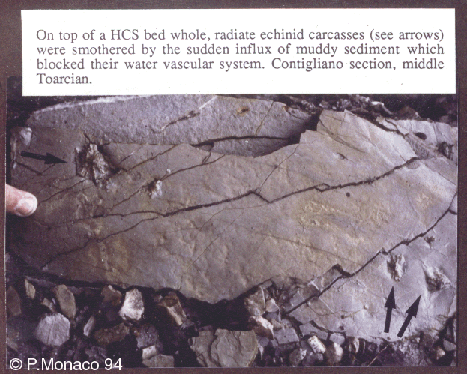
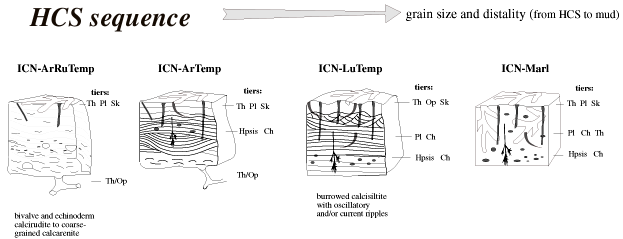
About the origin of HCS many papers have been published and several models have been proposed (see the "oceanographic" or "geologic" scenario and environmental settings reported in Walker 1982; 1984; Monaco 1992; Molina et al.1997 with abundant referencesz therein).
According to the classical model of Aigner (1985) for Triassic shelves, during episodic, very strong storm surges, wave stirring and onshore oriented wind-drift currents would be able to pile up skeletal debris, largely from crinoidal prairies, and accumulate nearshore skeletal banks in shallow-ramps (Aigner 1982; 1985). Water heaved onshore during major storms returns seaward, flowing along the bottom as a sediment-laden unidirectional density current (Fig.3). Close to the bottom falling grains encounter a zone of intense oscillatory sheet flow, which is moulding the bed into symmetric hummocks and swales. Consequently instead of forming Bouma sequences, the density current formed HCS, still under the influence of oscillatory regime (Walker 1982; 1984). Unidirectional bottom currents, together with oscillatory flows produced by the major storms, contributed to determine a wide-spread combined-flow regime. Evidence of oscillatory flows near the sea bottom is found in the characteristic abrasion surfaces on some benthic foraminifera tests, such as Lenticulina in the middle Toarcian interval and winnowed beds. Below the major storm wave base, instead, unidirectional flows are dominant and only calcareous turbidites, showing Bouma BC sequence, were deposited (Fig.3). When HCS deposits are present together with turbidites at depth about the major storm wave base level (Fig.3) the sole marks of the HCS beds are oriented in the same direction as those of turbidites. As reported from pelagic areas of Jurassic in Apennines and Spain, proximal deposits included crinoid ossicles (or other faunas in Spain) imported from nearshore and/or allochthonous bivalves (basal lags); distal deposits, instead, very similar to turbidites (see Monaco, 1996) were progressively fine-grained, mud-dominated and bioturbated, and contain reworked but parautochthonous bivalve faunas (Figs.2,3).
Sull'origine delle HCS tanto si è discusso e ancora si sta discutendo (vedi le citazioni in Walker 1982; 1984; Monaco 1992; Molina et al.1997). Alcuni pensano si tratti di strutture legate a flussi oscillatori legati a particolari regimi di corrente in shelf poco profondi dove si risente dell'azione della base d'onda di tempesta. Esistono comunque una miriade di modelli "oceanografici" e "geologici" estesi a tutti gli ambienti, più o meno dettagliati per spiegare queste strutture, che generalmente non si riescono a osservare mentre si formano attualmente durante un uragano. Il classico modello "geologico" di Aigner (1985) per rampe del Trias prevede un accumulo di banchi a crinoidi strappati e trasportati lungo lo shelf durante le tempeste, sia in senso diretto verso la terraferma, sia verso il mare aperto (correnti di densità unidirezionali cariche di materiale diversificato, Fig.3). In prossimità del fondo, con grande estensione laterale, i granuli incontrano potenti moti oscillatori e verticali innescati nella colonna d'acqua dai fortissimi venti legati alla tempesta (vedi la modellistica "oceanografica" dove si ritrova anche la distinzione tra tifoni, uragani e tempeste invernali a seconda delle latitudini e longitudini). Tali moti creano sul fondo zone circolari/ellittiche con accumulo progressivo di lamine di sedimento (gli hummocks appunto) e zone limitrofe con erosione o trasporto (swales) o winnowing di fango (winnowed beds). Il lag basale sembra venga trasportato per corrente unidirezionale (erosivo) su cui, a causa di un moto progressivamente oscillatorio/unidirezionale (flusso combinato), si viene a depositare la restante sequenza HCS con lamine incrociate a basso angolo. Al calmarsi dell'acme meteorologico su alcuni shelf (o aree pelagiche isolate poco profonde, vedi Giurassico di Spagna e Appennino) si assiste progressivamente al progressivo normalizzarsi dei moti ondosi (ripples simmetrici al top). Il trasporto verso il mare aperto (indicato dalle impronte di corrente alla base degli strati) sembra portare a depositi prossimali caratterizzati da lags erosivi, HCS, fino a depositi distali dominati da fango e lontani dall'area sorgente (Figg.2,3) che spesso sono molto simili a torbiditi nell'aspetto fisico con strutture tipo Bouma o altri caratteri (vedi Monaco, 1996).
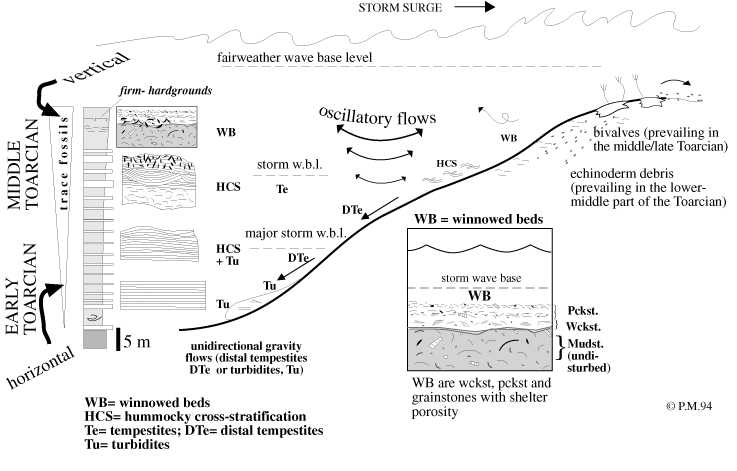
• AIGNER T., 1982 - Calcareous tempestites: storm-dominated stratification in upper Muschelkalk limestone (middle Trias,SW Germany). In Einsele G. & Seilacher A. (eds.) Cyclic and Event stratification, Springer Verlag, Berlin, Heidelberg, N.Y.: 180-198.
• AIGNER T. 1985 - Storm depositional system. In Friedman G.M, Neugebauer H.J. & Seilacher A. (eds.): Lecture notes in Earth Sciences, Springer Verlag, New York, Berlin, Heidelberg, 174 pp.
• BROMLEY R. G. C. 1990 - Trace fossils, biology and taphonomy. Unwin Hyman Ltd, London, 280 pp.
• KREISA R.D., 1981 - Storm-generated sedimentary structures in subtidal marine facies with examples from the middle and upper Ordovician in southwestern Virginia. Journ. of Sediment. Petrol., 51 (3): 823-848.
• MOLINA J.M.,RUIZ-ORTIZ P.A. and VERA J.A. (1997). Calcareous tempestites in pelagic facies (Jurassic, Betic Cordilleras, Southern Spain). Sedimentary Geology, 109: 95-109.
• MONACO, P. (1992). Hummocky cross-stratified deposits and turbidites in some sequences of the Umbria-Marche area (central Italy) during the Toarcian. Sedimentary Geology, 77: 123-142.
• MONACO, P. (1994). Hummocky cross-stratification and trace-fossils in the middle Toarcian of some sequences of Umbria-Marche Apennines. 3ème Symp.Intern. de Stratigr. du Jurassique, Poitiers, 20-29 Sept, 1991. Geobios, M.S.17: 679-688.
• MONACO, P., NOCCHI, M., ORTEGA-HUERTAS, M., PALOMO, I., MARTINEZ, F. AND CHIAVINI, G.., (1994). Depositional trends in the Valdorbia section (central Italy) during the Lower Jurassic, as revealed by micropaleontology, sedimentology and geochemistry. Eclogae geol Helv, 87(1): 157-223.
• MONACO P. (1996). Ichnofabric as a tool to identify turbiditic or tempestitic substrates: two examples from Early Jurassic and Middle Eocene in the central Apennines (Italy). Reunion sobre Tafonomia y Fosilizacion “Taphos 96”, Zaragoza 13-15 Junio 1996, 247-254.
• VERA J.A. and MOLINA J.M. (1998). Shallowing-upward cycles in pelagic troughs (Upper Jurassic, Subbetic, Southern Spain). Sedimentary Geology, 119: 103-121.
• WALKER R.G., 1982 - Hummocky and swaley cross stratification. In Walker R.G. (ed.) Clastic Units of the Front Ranges, Foothills and Plains in the area between Field, B.C. and Drumheller, Alberta, Int. Ass. of Sedim., 11th Int.Congr. on Sedim. (Hamilton, Canada), Guidebook to Excursion 21A, 22-30.
• WALKER, R.G. 1984: Shelf and shallow marine sands. In: Facies Models 2nd Edition (Ed. by R.G. Walker), Geoscience Canada Reprint Series 1, May 1984, 141-170.